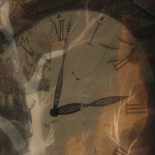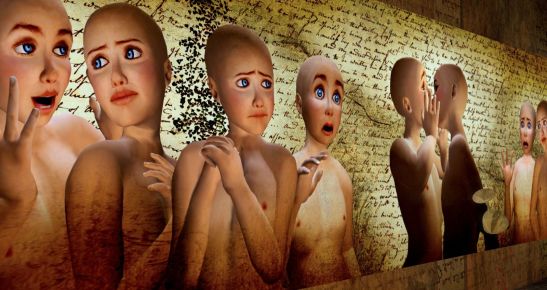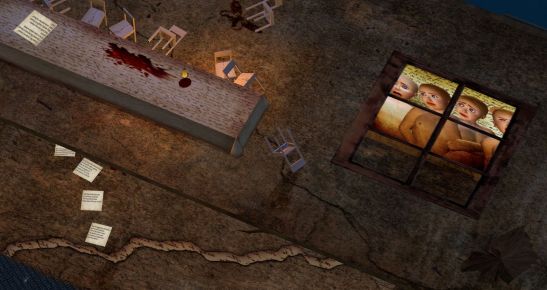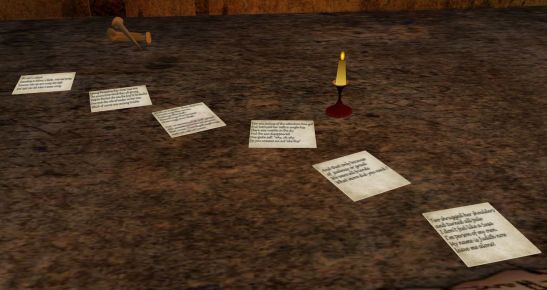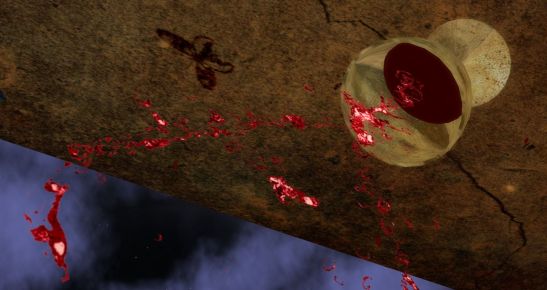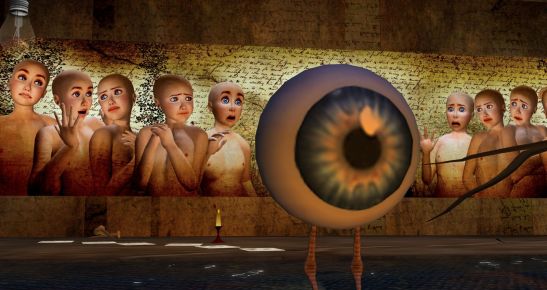Ekphrasis Extra: Bursting the Susa Bubble
Photographs by PJ Trenton
After a brief SL/Ekphrasis hiatus for RL European travel adventures, what a palaver of a week I’ve come back to! First the whole announcement of the M Linden debacle; and most recently, the depressing news of Maxwell Graf’s deletion of LagNMoor in protest to Linden Lab’s gross neglect of content theft issues. But in between these events was another hubbub which I’m sure most readers are now familiar: the removal of certain artworks at the SL7B celebration for inappropriate content.

“The Kiss”, by Rose Borchovski, 2010. The artwork (and artist) were banned from SL7B for alleged nude content.
I don’t wish to rehash the fallout here, but the call and response has been rather interesting. I was particularly intrigued (and a little excited) with yesterday’s entry of filmmaker Peter Greenaway into the debate, whose work I’ve been a fan of since I was a teen. [For full background on the incident, as well as a slew of comments of varied opinions, I recommend New World Notes’ reportage.] But I’d like to just take a little space to talk about the one aspect of this that few have really discussed: the artwork itself.
I admit that when I first heard the news of what was happening, I felt rather apathetic. I hadn’t seen either of the banned works, although Scottius Polke and Saffia Widdershins had brought me up to speed on the debate. I assumed, as many have, that it was some lovely artist stirring the pot. As so many have said, the rules were clear, and they knew the deal, and it is LL’s right to remove offensive content. Although when I heard that one of the offending pieces was Misprint Thursday’s inclusion of a nude Barbie Doll, I WAS admittedly baffled (I mean, don’t kids see them naked all the time, anyway? It isn’t as if she had attachments – I hope!).
Then I received an IM from the University of Western Australia’s Jayjay Zifanwe asking me if I knew the other banned work, Rose Borchovski’s Susa piece, “The Kiss”, and what I thought of it. When I told him I wasn’t familiar yet, Jayjay informed me the work was up at the UWA sim, and invited me over for a look. “Oh!” I said, when I saw it, “It’s those pseudo-humanoid androgynes that creeped out PJ (Trenton) and I when we saw them a couple months ago.” I laughed, remembering, then decided I better really look this time, because I admit, I wasn’t as impressed in that first instance.
My next thought, upon looking at the mural of the 13 androgynous figures which is at the heart of this piece was: “These are NUDE? They are barely human.” I suppose they have fledgling breasts. But they are closer to shirtless boys… are males not allowed to be shirtless in a PG sim? I thought it was only women’s breasts we’re paranoid about. Honestly, there was nothing offensive that I saw in these images, they are just a little disturbing.
In her response to Linden Labs, Borchovski said this about her work:
The story of Susa is a sweet but savage story, told in image and text, sound and installation. It is about our dark inside, but also shows how vulnerable and lonely we all can be. My art shows a naked body, but it is not about nudity or sex.
The figures, which are part of a larger narrative that is told through several other installations, are called Susas (her other works, which I’ve only had glimpses of through reading up on this controversy, are worthy of their own discussion). But studying “The Kiss” on its own, without knowledge of the others, I noticed something rather glaring about it, and which gave me pause in consideration of the SL7B ban. Indulge me a moment?
“The Kiss” is constructed in a diorama-like space, on the roof of which we find a long table with overturned chairs, the distraught face of a Susa etched on the bottom of each. On first impact, it is clear that this is a scene of a shocking, perhaps even violent incident. A pool of wine – or is it blood? – is smeared ominously on the table. The rest of the space is barren of anything else save a lifeless tree, and a single lamp and sheaf of paper -upon which is a short text – upon the table.

Detail of underside of a chair.
Below, we find the recorded memory of what clearly occurred above: upon the wall is the mural of Susas, five on the left and six on the right wearing various expressions of shock and horror; flanking two at centre who are engaged in an uncomfortable kiss. A chalice tumbles into our space, spilling more wine/blood, even as droplets fall like rose petals from the space above. A single lamp burns on the floor, next to scattered pages on which is written the tale of what has occurred (there are also voices narrating the tale, adding quite a haunting atmosphere).
The tale begins with the Susas making the declaration “We need a religion | Something to believe, a leader, wise and strong.” Susa one is chosen, “the source from which they all sprung”, and all seemed well, “but Susa Two kept sighing not at all at ease.” Then:
Two was jealous of the attention One got
And betrayed her with a single kiss
There was a rumble in the sky
And the sun disappeared
One spoke soft. “why, oh why
Do you commit an act like this”
…
Two shrugged her shoulders
and turned all pale
I don’t feel like a Susa
I’m a person of my own.
My name is Judith now
Leave me alone!
It doesn’t take a biblical scholar to see the relation to the story of Judas’ betrayal; nor any great leap to make the connection between the names Judas and Judith. Does Susa Two – Judith now – make her betrayal out of jealousy? Or out of a desire to be her own person, to burst out of the Susa Bubble? It is also worth considering that the name Judith does NOT relate to Judas, but rather is the feminine of Judah; and in terms of biblical significance, references an old testament heroine.

Artemisia Gentileschi. Judith and Maidservent with the Head of Holofernes 1625. Oil on canvas, 6′ 1/2″ x 4’7″ (1.84 x 1.41 m). The Detroit Institute of Arts Gift of Leslie H. Green.
A beautiful jewish widow, Judith infiltrated the conquering Holofernes’ camp by gaining his trust (possibly by seduction), and, being granted access to his tent while in a drunken stupor, she neatly removed his head and, with her maid, returned to her own people, having slain the tyrant. Judith betrayed Holofernes for her people’s freedom; this Judith seems to be doing the same, breaking the ‘friendship’ here for her own independence, perhaps paving the way for the others.
Need more evidence of the biblical correllary? That table on the roof obviously connects to the Last Supper, as to the composition of the figures (thirteen, the same number as Christ and the twelve apostles) reference conventional representations of that scene. And there is more: the grail, the blood of Christ, nails, a barren tree – just so much iconography in this space.
In short, I was obviously fascinated by Borchovski’s work. And I also couldn’t help but draw connections between the Susas and the even more disturbing conjoined mannequins – seemingly failed genetic experiments – of the contemporary British artists Jake and Dinos Chapman. My mind whirled making connections between art, religion, science, clones, bodies, avatars… Second Life.
And at the end of this mental journey, I thought, this is EXACTLY the kind of work I would want to see at an event which, rather than being a mere ‘Birthday Party’ as some have suggested, should be a showcase for the achievements of this particular Virtual World. It is thought-provoking, and yes, sensational, but that should be celebrated, not banned. But this is just my opinion, and I know this work won’t appeal to many.
But after viewing “The Kiss”, I had to ask: although nudity was the ostensible reason this work was banned, one has to wonder to what extent the decision was influenced not just by this, but by the challenging and controversial nature of this work – and its relationship to and critique of Christian motif, with its powerful and sophisticated use of Christian iconography in a new and, quite frankly, disturbing context. This element should not be ignored, and I haven’t seen ANYONE talking about it (point it out if I missed it in the sea of commentary).
At which point we have to ask – what is truly being silenced here? A lot of the criticism at the moment seems to be centred around what people are claiming of Rose Borchovski, the artist herself, that she is something of a firecracker; that she is attention-seeking – and these are the most moderate of the terms being bandied about. But that is neither here nor there to me when the work she produces is this captivating – it speaks for itself. And say what you will, I think one of the final comments in her response to Linden Labs is spot on:
The worst part of censorship is not that which is censored, but the climate of self-censorship it imposes on all artists. Art is about having a voice. Art is about thinking differently and about thinking from fresh perspectives. When artists are not allowed to have a voice, culture is not allowed to progress.
Was this work censored? I’m still not sure, to be honest. I hope not. But I shall thank the Lindens for one thing – making me pay attention to an artist I mistakenly dismissed. Now, excuse me while I go explore the rest of this fascinating body of work.
New to Ekphrasis? Catch up on the previous posts here:
- Ekphrasis: An Introduction
- Ekphrasis: Ragamuffin Kips
- Ekphrasis: PJ Trenton
- Ekphrasis: Chrome Underwood
- Ekphrasis: Glyph Graves
- Ekphrasis: Gracie Kendal
- Ekphrasis: Scottius Polke
Originally published on the Prim Perfect Blog
